If you’re a fan of this spice’s bold, spicy, and deep taste, you’ll fall head over heels for my other harissa recipes. My Homemade Harissa Recipe is an essential condiment for any spice lover, while my Harissa Vinaigrette will transform any weekday salad into a flavor-packed meal.
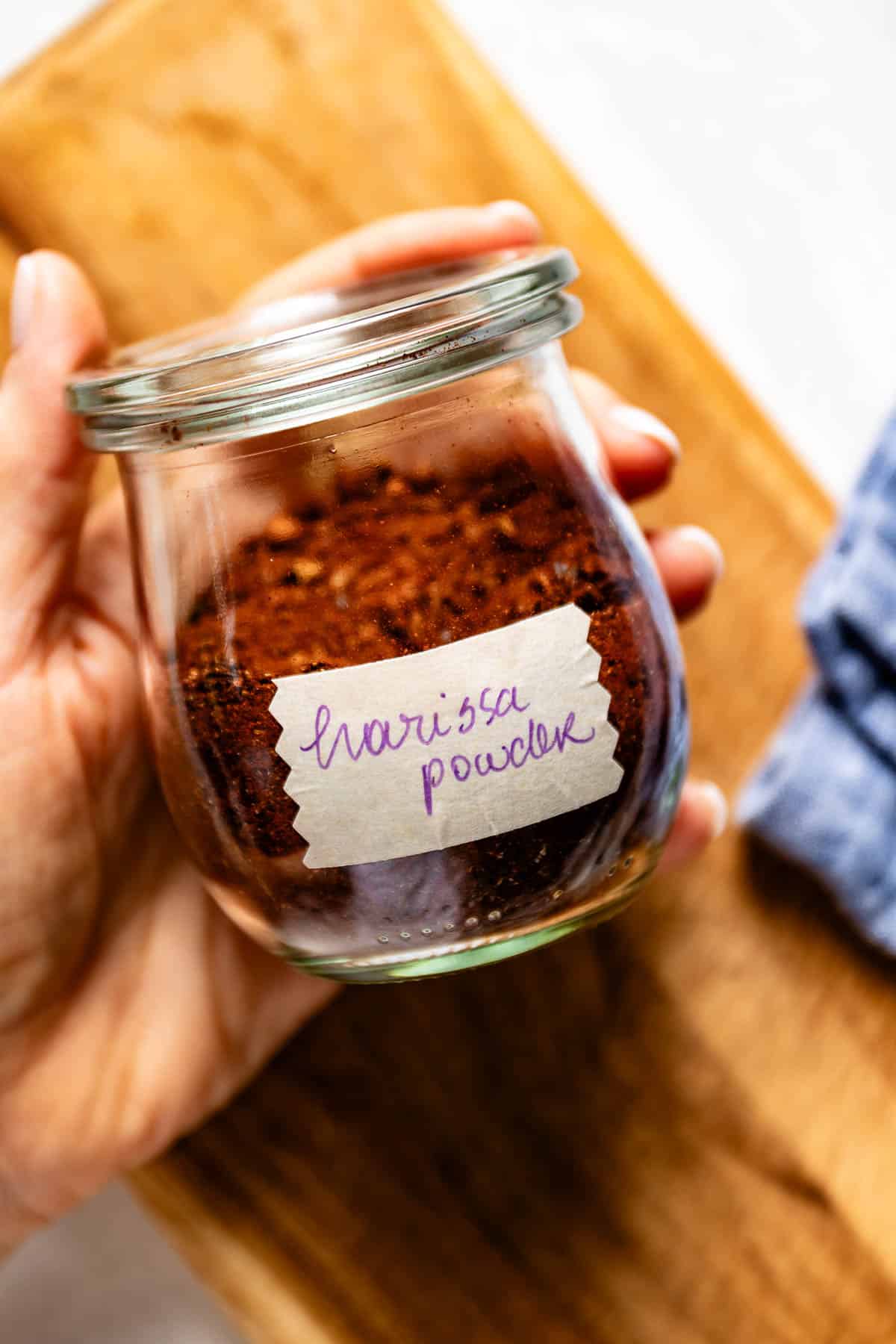
What is Harissa Spice?
Harissa spice—also referred to as a “harissa spice blend,” “harissa seasoning,” or “harissa powder”—is a spicy, aromatic seasoning made from a mixture of dried chili peppers and other spices, such as cumin, coriander, and caraway seeds.
This hot seasoning is native to Tunisia, though it’s since spread to other areas in North Africa and the Middle East, including Algeria, Morocco, and Egypt. Because of its vast popularity, harissa powder has developed many uses, including in condiments, dry rubs, and other food seasonings.
What is in Harissa Powder?
This authentic spice recipe is easy for anyone with a simple mix of natural spices. I’ve listed my favorite harissa powder ingredients below, including the best chilis to use, classic spices, and tasty add-ins.

- Dried chilies: This harissa seasoning recipe works with virtually any dried chili pepper, making it incredibly customizable in taste and heat. My favorite combination includes ancho, guajillo, and de arbol chilies. I usually buy this trio of chile peppers online (affiliate link), but you can also find them in the “Mexican” or “Latin” section of your local grocery store. Additionally, even though my mix primarily uses Mexican dried chilies, you can also cut back on spiciness by adding more New Mexican dried chilies, which tend to have a milder flavor.
No matter which chilies you use, during our recipe testing, we found that 7-8 chilies of various kinds work best in this recipe. - Spices: Cumin seeds, coriander seeds, caraway seeds, and peppercorns are the best warm spices to give this mix added fragrance and earthiness. If you can, I highly recommend buying organic spices.
- Seasonings: I recommend adding smoked paprika and garlic powder to this harissa blend for greater depth and complexity.
- Optional add-ins: Nowadays, many commercial harissa spice blends include additional flavorings like rose petals and lemon peel. To achieve a similar floral flavor profile in your homemade blend, add ½ teaspoon of crushed, food-grade rose petals and lemon peel. For extra heat, include a pinch of cayenne pepper or red pepper flakes.
How to Make Harissa Powder
This authentic, restaurant-worthy harissa powder recipe takes less than 15 minutes to make. Plus, you only need a handful of ingredients, a skillet, and a good food processor (affiliate link).

- Prepare the chilies: Remove the stems and seeds of the ancho, guajillo, and de arbol chili peppers. Then, chop them roughly.
- Toast the peppers: Heat the cast iron skillet over medium heat and add the chopped chilies. Stirring constantly to avoid burning, toast them until thoroughly dried (4-6 minutes). To test whether the chilies are ready, see whether they “crack” or “snap” under pressure. When they do, you can remove them from the pan.
- Cool: Transfer the toasted chili peppers to a plate to cool, and set them aside.
- Toast the seeds: Add the cumin, coriander, coriander seeds, and peppercorns to the heated skillet. Cook them for 1-2 minutes, stirring frequently, then remove them from the pan. Set them aside to cool.
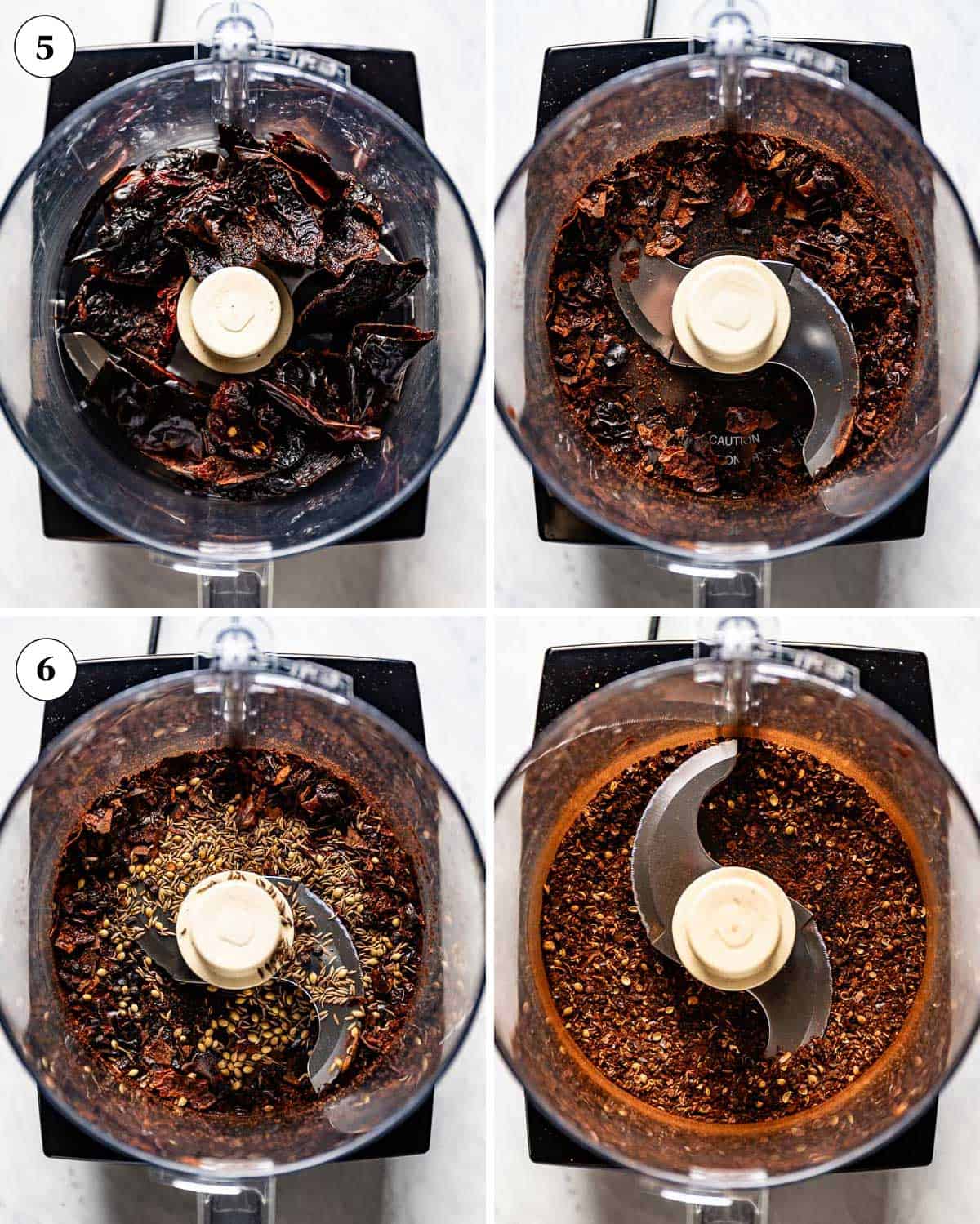
- Process the peppers: Transfer the cooled chili peppers to your food processor bowl fitted with the blade attachment. Pulse the processor 7-10 times until the chilies break down.
- Add the toasted seeds: Then, add the toasted seeds and peppercorns to the bowl. Continue processing—being sure to scrape down the processor bowl every so often—until the ingredients reach a powder-like consistency and are fully incorporated. This step should take 1-2 minutes, depending on the brand of your food processor. Once you get your desired consistency, add the smoked paprika and garlic powder and pulse it for another 2-3 times.
- Store: Scrape the powder into an airtight jar or container and store it at room temperature for up to six months.
Ways to Use Harissa Spice Blend
Because of its bold flavor and broad versatility, harissa spice provides an indispensable taste to dozens of recipes. Below are just a few of my favorite dishes harissa seasoning can be used for.
- Salad dressing: You can use this harissa powder recipe to make my harissa vinaigrette dressing (famously used when making CAVA Bowls). It is a wonderful way to season and elevate any salad recipe. Or, if you’re in the mood for lighter, zestier options, add a teaspoon to my Yogurt Salad Dressing and Lemon Salad Dressing to introduce the earthy flavors of harissa to your salad dressings.
- Roasted vegetables: If you’re into roasting vegetables—like carrots, bell peppers, and potatoes—this easy recipe perfectly complements their smoky, tender notes. Simply sprinkle a few teaspoons of harissa powder over veggies before roasting them in the oven.
- Seasoning for meat and seafood: Harissa spice makes an excellent dry rub for all your favorite recipes, from chicken to beef, fish, and lamb. In particular, you can use this seasoning for classic Middle Eastern dishes, like my Baked Chicken Kabobs, Roasted Turkey Tenderloin, and Grilled Rack of Lamb.
- Dips: You can quickly transform this seasoning into a crowd-ready dip by adding it to a creamy Mediterranean Hummus or making Harissa Aioli—a delectable accompaniment for burgers, sandwiches, French fries, and more. You can even add harissa powder to ketchup to give it spicy, complex dimensions!
- Marinades: Besides being a great seasoning, this harissa spice blend recipe makes a deliciously hot, full-bodied marinade when combined with extra virgin olive oil, lemon juice, and other flavorings. Try it in my citrusy Shrimp Marinade, creamy Yogurt Chicken Marinade, or bold Mahi Mahi Marinade to infuse your meat with rich, flavorful notes.
- Grains and rice: You can give any grain bowl or side dish a kick of heat by sprinkling it with harissa seasoning. I love adding this spice blend to dishes like couscous, rice, and rich pilafs (especially my Wild Rice Pilaf and Chicken Herb Pilaf!).
- Eggs: If you love to start your mornings with a spicy wake-up call, I highly recommend using harissa powder to season savory breakfast recipes like scrambled eggs and shakshuka.
- Soups and stews: A teaspoon of harissa powder infuses any soup or stew recipe with deep, aromatic spice. For the tastiest combination, I recommend pairing this recipe with equally hearty, chili-friendly dishes, like Eggplant Beef Stew, Chicken Chili, or—for a lighter variation try it in my Vegan Chili instead of chili powder.
Aysegul’s Expert Tips
Easy to make and unbelievably versatile, homemade harissa powder is vital to any chef’s spice rack. These tips ensure you make the freshest, most flavorful seasoning with zero hassle.
- Wear gloves: Chili peppers are notorious for their spiciness due to their high levels of the compound capsaicin. Though capsaicin is vital to giving chilis their flavor, it may cause a burning sensation after direct contact. Therefore, wearing gloves when working with them is a good idea. If you don’t have any gloves on hand, however, be sure to thoroughly wash your hands after handling your chili peppers.
- Adjust heat: You can easily adjust your seasoning’s heat levels by changing a few simple factors. For a hotter blend, use a spicier mix of dried chilies, leave the seeds in your chili peppers, or add ½ teaspoon of cayenne pepper. For a milder mix, remove as many seeds from your chilies as possible and try to select chili peppers that land lower on the Scoville Scale—in particular, New Mexico chiles.
- Adding salt: I did not add salt to my harissa spice blend recipe, as I prefer to adjust the amount of salt according to the recipe I plan to use. This way, I can easily control the amount of salt in my food without the risk of making it overly salty.
- Spice grinder: I prefer to blend my harissa spices using a food processor. The bowl of a food processor is large enough to pulverize everything in one take, and its strong blades are ideal for turning all spices and dried chilies into powder. However, you can also make this recipe using a spice grinder (affiliate link.)To do so, blend the cooled chili peppers, one tablespoon at a time, until powdered. Then, add the toasted cumin, coriander, caraway seeds, and peppercorns, and grind the mixture until it reaches your preferred consistency (about five seconds). Remember, too, that you might need to grind your ingredients in small batches to ensure they fit in your grinder.
FAQs
Suppose you don’t have harissa spice but still want the same aromatic, spicy taste. In that case, I recommend blending chili powder, smoked paprika, ground cumin, ground coriander, and garlic powder. Though not identical, this mix strikes a similar balance between fragrant heat and the earthiness of harissa powder. Or, if you need a condiment-like consistency, you can even try sriracha sauce for a store-bought, chili-based substitute.
Not a single spice, “harissa” refers to a hot, fragrant mix of multiple spices and dried chili peppers. You can find this traditional blend in several forms, including a dry seasoning, a paste form, and a creamy sauce.
In general, yes, harissa powder contains a fair amount of spiciness. However, if desired, you can adjust this heat level by using different combinations of chili peppers and spices to make a milder mix.
Since they both come from a similar mixture of dried chili peppers and spices, harissa powder and harissa paste boast a hot, earthy flavor. However, they have very different consistencies. Powdered harissa is a dry, powdered version of the mix, while harissa paste has a thicker, wetter consistency due to additional ingredients like tomato paste, lemon juice, and olive oil.
After trying several store-bought brands, I recommend purchasing either New York Shuk’s Fiery Harissa or Whole Foods Organic Harissa Seasoning (which is a little milder). These premade harissa blends will work in a pinch, though I find my homemade recipe more flavorful and customizable.
If you make your own Harissa Powder following our recipe, I would greatly appreciate it if you could take a minute to rate it and leave a comment below. It is a great way to support this website and help those planning to make it. Also, if you took pictures, I’d love to see them. Share your creations on Instagram using #foolproofeats so I can share them with the Foolproof Living community.
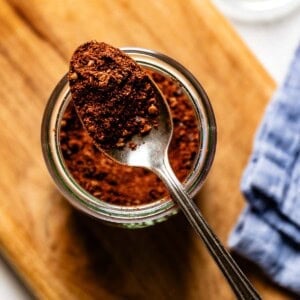
Harissa Powder Recipe
Equipment
Ingredients
- 8 dried chili peppers, we used a combination of Ancho, Guajillo, and De Arbol chili peppers
- 1 ½ teaspoons cumin seeds
- 1 ½ teaspoon coriander seeds
- 1 teaspoon caraway seeds
- ½ teaspoon peppercorns
- 1 teaspoon smoked paprika
- 1 teaspoon garlic powder
- 1 teaspoon kosher salt, optional*
Instructions
- Remove the stems and deseed the chili peppers. Give them a rough chop.
- Heat a cast iron skillet on medium-high heat. Add the peppers and toast for 4-6 minutes or until thoroughly dried. Stir frequently to avoid burning. To test for doneness, you should feel the chili pepper “crack” or “snap.”
- Place the toasted peppers on a plate to cool while working on the rest of the ingredients.
- Add the cumin, coriander, caraway seeds, and peppercorns to the heated skillet and toast, stirring frequently, for 1-2 minutes. Remove from the pan and set aside to cool.
- Place the cooled chili peppers into the bowl of a food processor (*instructions for making it in a spice grinder are below in the notes section) fitted with the blade attachment. Pulse the processor 7-10 times to break down the dried chilies. Add the toasted cumin, coriander, caraway seeds, peppercorns, and salt if using. Continue to process until they are pulverized and reach a powder consistency, scraping down the processor bowl to incorporate all the ingredients. Depending on your food processor, this takes about 1-2 minutes of processing. Finally, add the smoked paprika and garlic powder and pulse 2-3 times to ensure all spices are fully incorporated.
- Place the powder in an airtight container and store it in a cool and dark place for six months.
Notes
- Yields: This recipe makes about ⅓ to ½ cup harissa seasoning, depending on the size of your peppers. The nutritional values below are for the full recipe.
- If using a spice grinder: Add the cooled chili peppers, one tablespoon at a time, to the grinder and pulse to create a powder. Add the toasted cumin, coriander, caraway seeds, and peppercorns. Continue to grind until it reaches powder consistency. Add the smoked paprika and garlic powder if using. Grind for 5 seconds.
- Mortar and Pestle: If you do not have a food processor or a spice grinder, the good old mortar and pestle would also work.
- Adding salt: When I make homemade spice blends, I usually use very little or no salt. This way, I can salt my food separately and easily gauge the amount of salt used in my dish. Feel free to omit it or use more as needed.
- Storage: To store this harissa spice mix recipe, first transfer it to an airtight container. Then, store it in a cool, dry place—such as a pantry or kitchen cabinet—for up to six months.
- Wear gloves: Chili peppers are usually very hot, even when dry. I would recommend wearing gloves if you have them.
- Fumes: Proper ventilation is essential when cooking chili peppers. The fumes from these chilies may irritate your eyes, nose, and mouth, so I highly recommend opening windows, turning on your kitchen’s range hood, and/or using portable fans to increase your kitchen’s air circulation.
Nutrition
Nutrition information is automatically calculated, so should only be used as an approximation.
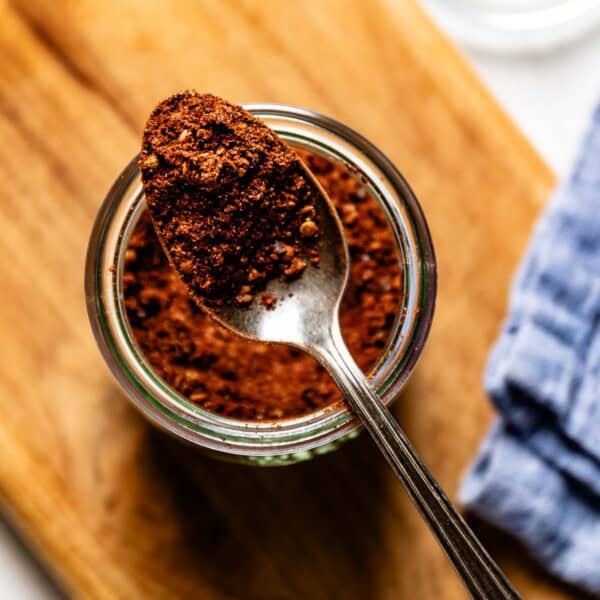


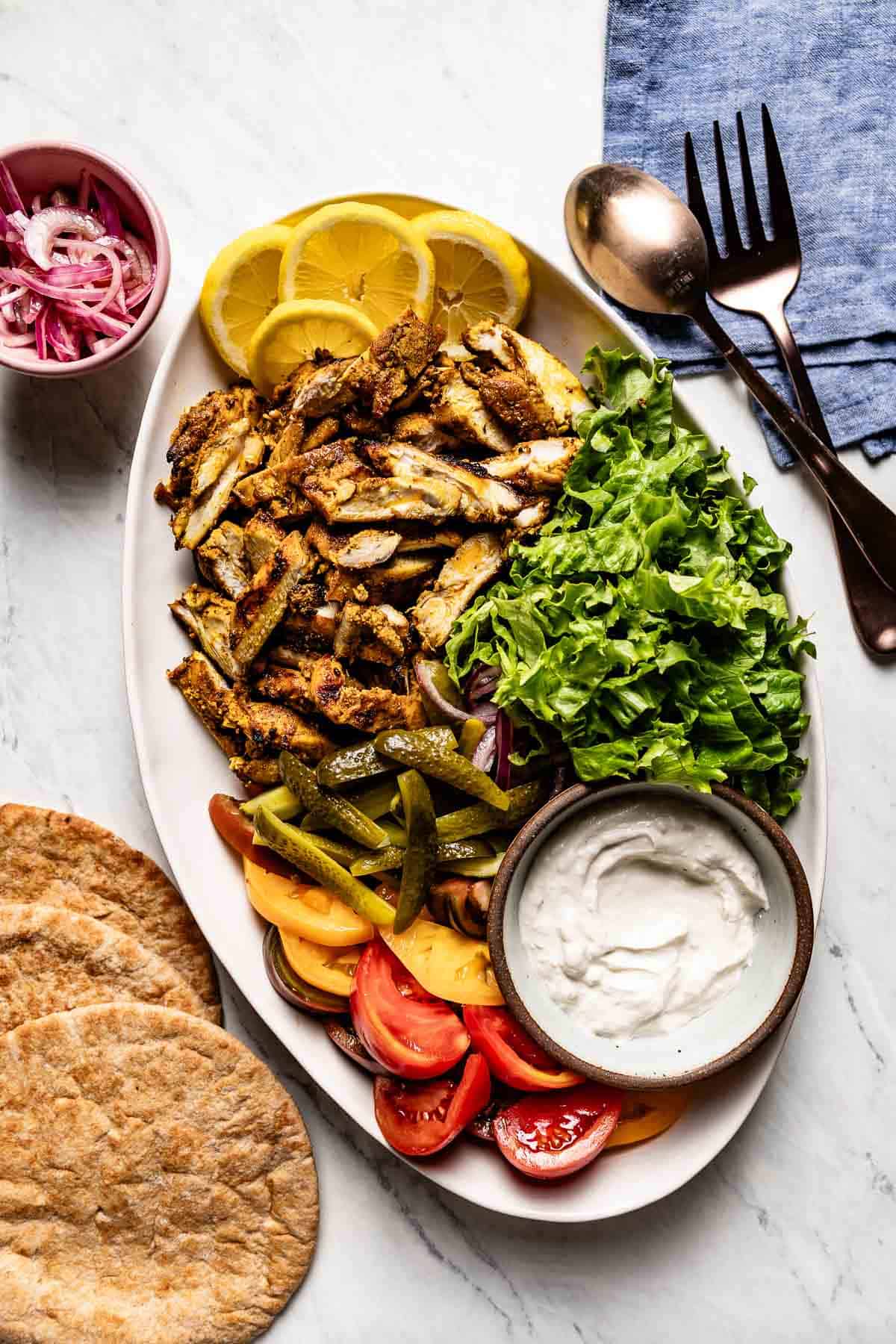











I’d like to substitute the dried chiles for ground guajillo / ancho / cayenne powder that I already have on hand. Any suggestions on how much to use? Maybe a tablespoon or two to equal 7-8 whole chiles?
Thanks,
Cat
Hello Cat,
I think 2 to 2 and a half tablespoons of guajillo and ancho (of each) is a good place to start. However, depending on how hot your cayenne is, I would use a lesser amount of cayenne. Perhaps, 1 teaspoon? Still, if you are a fan of heat use as much as you want.
Hope this helps.